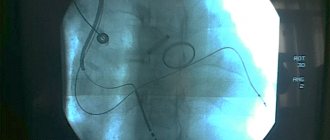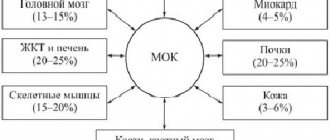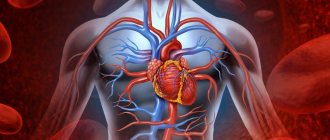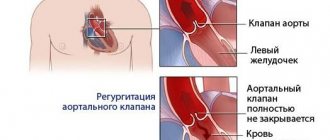In this case, the whole body suffers, but most of all the brain. That is why, when the first signs of illness occur, you should immediately consult a doctor. He will conduct an examination, prescribe the necessary tests and prescribe treatment based on the data obtained.
The disease can have an acute or chronic form. In chronic cases, the dog owner may not even suspect the presence of a problem, since specific signs are usually absent. The disease can develop over several months, and possibly even years. Moreover, it is hidden in nature and appears only when there is excessive stress on the dog’s body. The acute form develops rapidly. In this case, you need to urgently call a specialist, since the dog has difficulty breathing, sudden convulsions, blue mucous membranes and even loss of consciousness. Timely assistance will help save the dog's life.
Causes of heart failure in dogs
Not only older dogs, but also young dogs suffer from heart disease, and the prerequisites for their development can be identified even in puppyhood. The following may be the causes:
- genetic predisposition and congenital heart problems;
- vascular diseases;
- infectious diseases, weakened immunity;
- violation of coronary circulation;
- abnormal development of heart valves;
- cardiomyopathy;
- problems with the kidneys, adrenal glands, thyroid gland;
- long-term use of hormonal medications.
Veterinarians also identify certain dog breeds that are predisposed to developing health problems. These are Dobermans, poodles, collies, fox terriers, spaniels, bulldogs, St. Bernards, shepherds, spitz dogs, boxers, and giant schnauzers. The balance of physical activity also affects the functioning of the heart. A lack or, conversely, an excess of physical activity can cause the development of heart failure.
Symptoms
Symptoms depend on the disease causing heart failure. General signs:
- fast fatiguability;
- exercise intolerance;
- cough;
- dyspnea;
- sometimes fainting;
- the appearance of edema;
- pathological heart murmurs;
- increased heart rate (HR);
- heart rhythm disturbances;
- there may be pain on palpation in the heart area;
- disturbances in the functioning of the kidneys and liver appear;
- the worst thing that can happen is sudden death, without any previous symptoms.
The following symptoms are of great diagnostic importance:
- if there are signs of pulmonary edema, this indicates pathology on the left side of the heart;
- if we observe ascites, or stagnation of blood in the liver, we conclude that there is a disorder in the right half of the heart.
Bacterial endocarditis is characterized by:
- fever;
- lameness (non-specific symptom but worth paying attention to).
Externally appearing symptoms are not enough to make a diagnosis; it is necessary to conduct special studies to obtain data of greater diagnostic value.
Signs of the disease at different stages
Attentive dog owners may suspect the presence of the disease even in childhood. If at least 1 sign appears at a young age, then most likely we are talking about a congenital disease. In this case, the animal’s condition needs to be monitored for the puppy’s normal life and if there is the slightest change, consult a doctor. These may be sudden fainting, lethargy, constant sleep, refusal to eat, shortness of breath, blue mucous membranes. As an adult, the animal quickly gains weight, drinks a lot of water often, and coughs heavily. An elderly dog has swelling in the chest and paws, there is no appetite, the animal constantly wants to sleep and does not want to move.
Treatment
Having heard the conclusion “heart failure”, the first thing the owners ask the doctor is: “How long do dogs with this diagnosis live?” It all depends on the stage of the disease, the general condition of the animal, its age, the presence of concomitant diseases and compliance with all veterinarian recommendations.
Treatment of heart disease in dogs, as in people, requires strict adherence to the schedule of administration and dosage of medications. It is important to remember that, despite the same symptoms, treatment may be different for different dogs. Therefore, there is no need to listen to “comrades in misfortune” and try to help your pet by following their advice, since such help can be fatal.
The main points of complex treatment of heart failure are:
- Reducing the dog's physical activity by limiting exercise and reducing walking time.
- Elimination of the disease that caused heart failure (in the acute form of the disease). If the cause is an infectious disease, then it is necessary to prescribe antibacterial therapy; if infected with heartworms, anthelmintic treatment should be carried out.
- Ensuring stable blood pressure through the use of diuretics and vasodilators (Enalapril, Captopril, etc.).
- Drug support of the myocardium with potassium preparations (Asparkam, Panangin) and relief of cardiac arrhythmia with drugs from the glycoside class (Digoxin).
- Taking diuretics (Furosemide, Spironolactone ) to reduce pulmonary edema.
- Changing your diet to reduce the amount of salt and water.
Chronic heart failure in dogs means that treatment will be carried out throughout the dog's life. In this case, a complex of drugs consisting of diuretic, antihypertensive, antiarrhythmic and potassium-containing drugs can be supplemented with vitamins and medications to support the liver.
To prevent the owner from having problems with the dog’s nutrition, you can use ready-made food for animals with CHF, which has a significantly reduced sodium chloride content.
Prevention of the disease
There are some recommendations that will help avoid heart problems (with the exception of congenital defects), and they are as follows:
- Every dog should be periodically examined at a veterinary clinic. This will help avoid the risk of developing all diseases, including cardiovascular diseases. First of all, this instruction applies to large and small breeds of dogs, since they are at risk;
- The functioning of the cardiovascular system should be checked especially carefully if the dog is 7-8 years old;
- Dogs need optimal exercise. You cannot overtire her with exhausting activity and jogging, but at the same time, short movement is simply vital for her. The owner must first draw up a walking plan that will be comfortable for the animal;
- In the summer, it is recommended to take active walks in the early morning and late evening so that the dog does not become overtired from the heat. If you have a long trip by car, you need to make sure you have water in advance.
Disease Prevention
If you have taken the liberty of getting a dog, then try not to forget about it. And always remember that a dog requires constant attention. Values his owner. That the animal is always grateful to him simply for having an owner. This pet needs your constant love and care. To avoid such diseases it is necessary:
- explore your dog's physical abilities. Select and regulate her physical activity. To do this correctly, you must take into account the breed of your dog. After all, the physical capabilities of each animal are different.
- It is vital for a dog to exercise a lot. Constant movement is normal for her.
- You should not keep your pet on a leash all the time. And it’s also not worth keeping it within four walls in an apartment. Garden, field, square, forest - animals need space.
- You need to take your dog for a walk several times a day. Walks should be enjoyable, not tiring, for your four-legged friend.
- You can’t limit yourself to just one long walk a day.
- When talking about your pet’s nutrition, you need to take into account its age, breed, and personality traits.
- Make sure your diet is balanced. Your dog's diet must contain proteins, fats, and carbohydrates. But at the same time, there should always be a place for minerals and vitamins in an animal’s diet.
- When preparing the next portion of food each time, you must constantly keep track of the amount of salt that gets into your pet’s food. And also monitor how much fat your dog gets with each meal.
Starting from the age of six, all dogs become candidates for the so-called “risk group”. It is from this age that there is an increase in heart failure among dogs. Owners of four-legged friends need to know this:
- Dwarf dogs must be regularly examined by a specialist. Since they are very prone to heart diseases, especially heart failure.
- If your dog's nervous system is easily excitable, then he needs to visit the veterinarian quite often to know about the condition of his heart.
- Large dogs are also predisposed to heart failure. Owners of such dogs should remember this well.
- There are several dog breeds that are predisposed to cardiovascular disease.
The sooner heart failure is detected in an animal, the more effective the treatment becomes. After all, it is well known that a disease at an earlier stage is much easier to treat.
Currently reading:
- Detection of endocardiosis and its treatment in dogs
- Ways to manage parvovirus infection in dogs
- Prognosis and treatment of kidney failure in dogs
- Thyroid dysfunction in dogs (hypothyroidism)
Treatment of heart failure in older dogs
If you notice the first symptoms of an insidious disease, you should immediately make an appointment with a veterinarian. Self-indulgence can cause irreparable harm to the dog’s health. The doctor will conduct an examination, refer you for tests and prescribe appropriate treatment.
Many dog owners are very frightened by the diagnosis of heart failure. After thinking a little, people ask the doctor: “How long do dogs with heart failure live?” It is impossible to answer this unequivocally due to the age and individual characteristics of the pet’s body.
Complex treatment means not only taking prescribed medications, but also obligatory adherence to a diet. It is necessary to rely solely on the doctor’s recommendations, and not on the advice of friends with a similar diagnosis.
The most common drug for diagnosed interruptions in the cardiovascular system is the drug Vetmedin, which has a complex effect on the force of contraction of the heart muscle and blood vessels. Your veterinarian may also prescribe Furosemide for dogs with heart failure.
The dog owner can ask the veterinarian a completely appropriate question: “what can replace Vetmedin?” A complete analogue of Vetmedin is Pimobendan.
About the drug Vetmedin
The main active ingredient of the drug Vetmedin is Pimobendan, in addition to which there is povidone, microcrystalline cellulose, magnesium stearate, citric acid and anhydrous colloidal silicon. Vetmedin is usually prescribed to dogs with heart valve dysfunction and pronounced cardiomyopathy. The drug provides a complex effect, increasing the force of contraction of the heart muscle and expanding the lumen of blood vessels. This improves brain nutrition.
According to the instructions for use of Vetmedin, it is administered 2 times a day orally 1 hour before meals. The daily dose is calculated as 0.2–0.6 mg/1 kg of animal weight. This indicator directly depends on the age and severity of the disease, so a preliminary consultation with a veterinarian is necessary, he will also tell you about the timing of treatment. In the chronic form, the drug is officially allowed to be used for life. The medicine is available in tablets and capsules.
You can buy Vetmedin on the website of the veterinary pharmacy VetHouse, with the possibility of delivery throughout Russia. By following the link https://vet-house.com/products/vetmedin-125mg-100-tabletok you can get acquainted with the current price of Vetmedin 1.25 mg (tablets), or go further to the Product Catalog and order Vetmedin in any other dosage and release form.
Contraindications include individual intolerance to the components, renal and liver failure, hypertrophic cardiomyopathy.
Vetmedin is stored at room temperature in a dark place. Shelf life - 3 years. Do not use the medicine after the expiration date.
Examination and diagnosis
If you went to a veterinary clinic with complaints of shortness of breath, lethargy, loss of appetite in your pet and the doctor diagnosed “heart failure” only on the basis of examining and listening to the dog, then it is better to repeat the consultation in another institution, since diagnosing such a serious disease requires comprehensive examination.
If this pathology is suspected, in addition to auscultation, it is necessary to conduct several more instrumental studies:
- A general and biochemical blood test and urine test will help assess the general condition of the dog.
- A chest x-ray, in which the doctor can see dilated pulmonary veins, an enlarged heart, and fluid in the lungs, which are common in dogs with heart failure.
- Electrocardiography will tell you about the work of the heart itself, the presence or absence of arrhythmia, the size of the heart cavities, etc.
- Echocardiography (ultrasound) of the heart will allow you to evaluate the anatomy of the heart, the condition of the myocardium and monitor blood flow.
The most accurate diagnosis can be made only by conducting a full range of research data. However, none of them is a priority, but together they give the doctor the opportunity to get a complete picture of the situation.
Based on the data obtained, the veterinarian can predict how the disease will develop and develop a treatment plan.
Myocardial infarction
Myocardial infarction is a dangerous disease, as a result of which the blood supply to any part of the myocardium is stopped and after that it dies. The consequence of this pathology is a disruption of the functioning of the entire body, up to the death of the dog.
The clinical picture of a heart attack is characterized by severe pain in the chest area, panic in the dog, and a sharp change in the color of the mucous membranes. The prognosis for survival in dogs with a heart attack depends on the size of the affected area of the myocardium, the age and general condition of the animal.
Dog care
It is very important not to overload a sick dog, but at the same time prevent excess weight gain.
Provide your pet with a place in the house where nothing will disturb him; such dogs need peace.
Daily walks at a relaxed pace. There is no need to force the dog to run.
And of course watch your diet. The diet should be complete and balanced.
A dog's heart, what is it like?
The dog's heart is a hollow organ made up of muscles, the main one being called the myocardium. The heart has an inner membrane - the endocardium, and an outer membrane - the epicardium - covers it on the outside. In addition, it is placed in a special cardiac sac or pericardium, which protects the “main pump of the body” from shock, shock, infection and contact with other organs.
The heart is divided into two ventricles and two atria, with a common valve between the right atrium and the ventricle, and a second valve located between the left atrium and the ventricle. The third valve connects the left ventricle and the aorta emerging from it, and the fourth valve is located between the right ventricle and the pulmonary artery.
The job of all four valves is to ensure that blood flows through the heart in only one direction.
We have outlined the anatomical structure of the canine heart to give you an idea of why heart disease occurs in dogs.
Myocarditis
Inflammatory and infectious diseases can cause another type of heart defect in dogs - myocarditis, or inflammation of the heart muscle.
The development of myocarditis can be triggered by certain infections, intoxication of the body with poisons or excess medications, or injury to the heart by broken ribs.
The disease can manifest itself with the following symptoms:
- heart rhythm disturbance;
- dry cough;
- weakness of the dog;
- hard breath;
- temperature increase.
Treatment is prescribed in accordance with the cause of myocarditis










